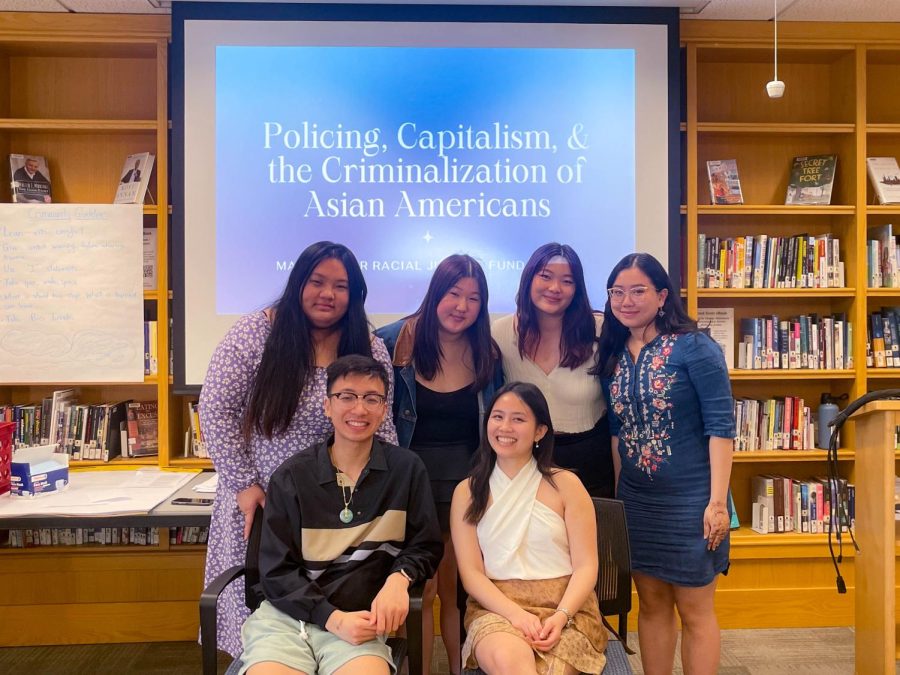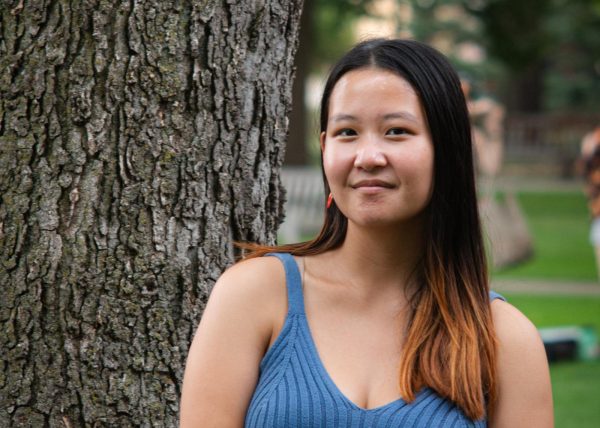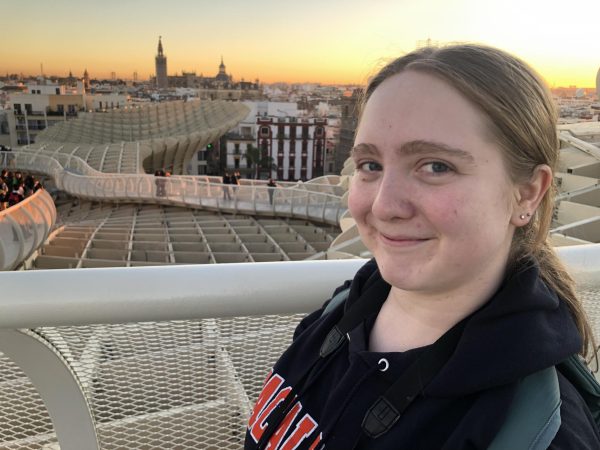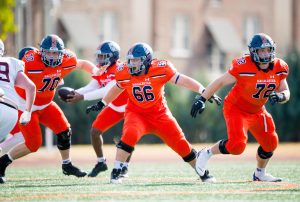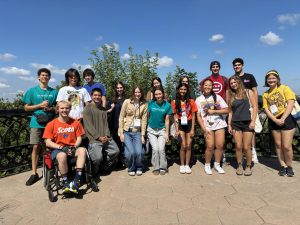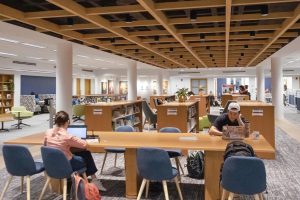Centering Asian American perspectives on racialized policing
Back row, from left to right, Pa Cheng, Marie Stebbings, Jacqueline Zhang, Rola Cao ’25. Front row, from left to right, Khai Hoang, Lily Dutton. Photo by Lucy Diaz ’24.
April 13, 2023
CW/TW: Racial discrimination, violence, prostitution
On Tuesday, April 11, the Lealtad-Suzuki Center for Social Justice hosted an event titled “Policing, Capitalism, and the Criminalization of Asian Americans.” The event was facilitated by organizing fellows from the Asian American Organizing Project (AAOP) and sponsored by Macalester’s Institutional Equity and the Racial Justice Project Fund.
AAOP is a civic engagement organization founded to advance Asian American and Pacific Islander participation in democracy and affect social change that encourages the development of individuals, families and communities. The organization aims to educate youth about social justice issues and how to take action against injustice. It also tackles difficult subjects such as immigration, mental health, gender justice and policing.
The goal of the event, hosted in the Harmon Room of the DeWitt Wallace Library, was to develop a space for participants to discuss their ideas about and experiences with police, capitalism and safety in America, specifically in the context of Asian American identities. It was comprised of three main sections, the “History of Policing in America,” “Property, Policing and Capitalism” and “How are Asian Americans Criminalized in the U.S?”
Rola Cao ’25, the Macalester student who led the organizing efforts for the workshop, used the money she was awarded by the Racial Justice Project Fund to organize a series of workshops and events in collaboration with AAOP. Communications & Digital Coordinator for AAOP Jacqueline Zhang highlighted three main themes that they hoped to target with these events.
“There’s three themes,” Zhang said. “Combating the model minority [myth], showing the cultural and political diversity of the Asian American community and subverting dominant narratives and stereotypes about Asian Americans.”
Fellows Program Coordinator, Marie Stebbings, expressed their hope that by working with Macalester and bringing the AAOP’s organizing effort to campus they can interact with students to teach more nuanced information about Asian Americans in a variety of areas beyond cultural diversity.
“College students have been a difficult demographic to tap into,” Zhang said. “[Through workshops] we can really connect with them and talk to them face to face, educate them. Both non-Asian and Asian students can really learn … more nuanced information about Asian Americans in relation to politics, not just cultural diversity or anything like that.”
When asked what they hoped participants would take away from the workshop, the organizers highlighted an increased desire to learn and engage more with the topics of safety in Asian American communities.
“We definitely want people to leave with a curiosity and desire to learn more about the specific ways Asian Americans have been impacted by police violence by imperialism within the United States, and hopefully a desire to learn how they can support the community as well,” Stebbings said. “Often Asian Americans are under-covered in the media, especially as it relates to systemic violence. And also a broader awareness of how we can all act in solidarity together there for safer communities.”
The presentation began with a familiar activity, in which participants were asked to move between sides of the room based on how much they agreed or disagreed with a series of statements. Following this, Pa Cheng, an organizing fellow, showed a video by the Washington Post that provided context on the origins of the police and the context within which they as a force were founded.
Presenters challenged the idea that the police were created to function as a protective service to the community. The organizers drew connections between the establishment of the police force, the abolition of slavery and increases in industrialization and immigration.
“What the history does is allow us to decouple the idea of public safety from the idea of police,” Chenjerai Kumanyika, assistant professor of journalism and media studies at Rutgers University said in the video. “What actually protects women from rape and from sexual assault? What actually stops people in communities both Black and white from killing each other? What kinds of things actually help people who are mentally ill? Are those things police?”
The next section on the connection between policing and capitalism tied in the idea of police as a mode of political power rather than safety, examining the timeline of policing both in the U.S and internationally. Khai Hoang, another organizing fellow, explained that as police forces were established, they were driven by merchants who wanted to protect their goods. Thus, the burden of paying for mercenaries to do so was pushed onto the general population through taxes by arguing that this was for the public good.
Utilizing Singapore as a case study, Hoang provided context of what an overpoliced country looks like. Singapore has one of the highest GDPs per capita, but has extremely strict laws regarding gum, littering and drugs. Lee Kuan Yew, often referred to as the father of Singapore, established a vision for Singapore as a capitalist utopia. According to him, the most difficult part of that transition was getting people to change their habits so that they behaved more like first world citizens.
“You see this connection between wanting to be this capitalist paradise, and creating and forging the world through his vision at the cost of some of his citizens’ liberty,” Hoang said of the former Prime Minister.
The second case study included was from the Nixon administration in the United States. Citing John Ehrlichman, former Assistant to the President for domestic affairs, Hoang emphasized how the police are used to serve the government’s agenda.
“We knew that we couldn’t make it illegal to be either against war or Black,” Ehrlichman said. “But by getting the public to associate hippies with marijuana, and [Black people] with heroin, and then criminalizing them both heavily, we could disrupt those communities. We could arrest their leaders, raid their homes, break up their meetings, and vilify them night after night, on the evening news.”
This reiterated that the heavy criminalization of Black, Indigenous and People of Color communities is directly tied to surveilling civilians and suppressing their protesting power.
The final section of the presentation, titled “How are Asian Americans Criminalized in the U.S?” included a timeline activity, facilitated by Lily Dutton, in which participants were given historical events and time periods, and asked to match each event to the time during which it occurred. Through examining cycles of immigration from different Asian countries, it became clear that as populations grew, the government took quick action to prevent any one immigrant population from becoming influential or prominent.
Maintaining Asian immigrant populations as a source of cheap labor was accomplished through the association of Asian women with sex work and stigmatizing interracial marriage to minimize children born to an immigrant parent. Laws such as the Chinese Exclusion Act, the creation of Japanese internment camps during World War II and the Page Exclusion Act are all evidence of how this capitalist motivation was codified into law.
Discussing how the workshop itself came together, Hoang explained the shared interest of the fellows in community safety which led to this subject being the focus of their work.
“We all care about safety … because it’s on the streets that we live in, it’s our neighborhood,” Hoang said. “We all deeply care about that. One thing we noticed [is] Asian Americans aren’t typically included in the conversation.”
“We want to introduce this workshop and create a workshop to get people to be more aware about the resources available for them,” Hoang continued “[And to] understand more of the origin of policing, the dynamics of safety in the Twin Cities.”
The event organizers highlighted how conversations about police often center around those of Black and white identities, and that Asian Americans are often left out of this conversation, despite rising numbers of anti-Asian hate crimes. Their goal of better understanding Asian Minnesotan youth perspectives on community safety and policing culminated in a video documentary that is available at bit.ly/ofdocu.

